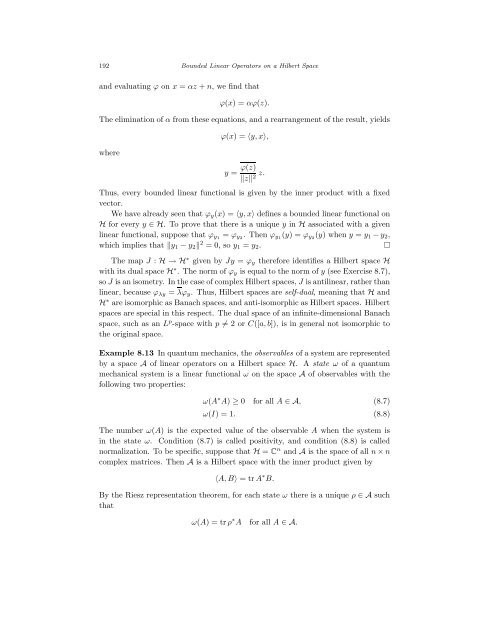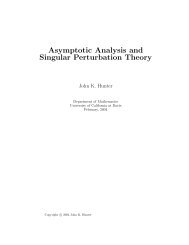Bounded Linear Operators on a Hilbert Space
Bounded Linear Operators on a Hilbert Space
Bounded Linear Operators on a Hilbert Space
You also want an ePaper? Increase the reach of your titles
YUMPU automatically turns print PDFs into web optimized ePapers that Google loves.
192 <str<strong>on</strong>g>Bounded</str<strong>on</strong>g> <str<strong>on</strong>g>Linear</str<strong>on</strong>g> <str<strong>on</strong>g>Operators</str<strong>on</strong>g> <strong>on</strong> a <strong>Hilbert</strong> <strong>Space</strong><br />
and evaluating ϕ <strong>on</strong> x = αz + n, we find that<br />
ϕ(x) = αϕ(z).<br />
The eliminati<strong>on</strong> of α from these equati<strong>on</strong>s, and a rearrangement of the result, yields<br />
where<br />
ϕ(x) = 〈y, x〉,<br />
y = ϕ(z)<br />
z.<br />
z2 Thus, every bounded linear functi<strong>on</strong>al is given by the inner product with a fixed<br />
vector.<br />
We have already seen that ϕy(x) = 〈y, x〉 defines a bounded linear functi<strong>on</strong>al <strong>on</strong><br />
H for every y ∈ H. To prove that there is a unique y in H associated with a given<br />
linear functi<strong>on</strong>al, suppose that ϕy1 = ϕy2. Then ϕy1(y) = ϕy2(y) when y = y1 − y2,<br />
which implies that y1 − y2 2 = 0, so y1 = y2. <br />
The map J : H → H ∗ given by Jy = ϕy therefore identifies a <strong>Hilbert</strong> space H<br />
with its dual space H ∗ . The norm of ϕy is equal to the norm of y (see Exercise 8.7),<br />
so J is an isometry. In the case of complex <strong>Hilbert</strong> spaces, J is antilinear, rather than<br />
linear, because ϕλy = λϕy. Thus, <strong>Hilbert</strong> spaces are self-dual, meaning that H and<br />
H ∗ are isomorphic as Banach spaces, and anti-isomorphic as <strong>Hilbert</strong> spaces. <strong>Hilbert</strong><br />
spaces are special in this respect. The dual space of an infinite-dimensi<strong>on</strong>al Banach<br />
space, such as an L p -space with p = 2 or C([a, b]), is in general not isomorphic to<br />
the original space.<br />
Example 8.13 In quantum mechanics, the observables of a system are represented<br />
by a space A of linear operators <strong>on</strong> a <strong>Hilbert</strong> space H. A state ω of a quantum<br />
mechanical system is a linear functi<strong>on</strong>al ω <strong>on</strong> the space A of observables with the<br />
following two properties:<br />
ω(A ∗ A) ≥ 0 for all A ∈ A, (8.7)<br />
ω(I) = 1. (8.8)<br />
The number ω(A) is the expected value of the observable A when the system is<br />
in the state ω. C<strong>on</strong>diti<strong>on</strong> (8.7) is called positivity, and c<strong>on</strong>diti<strong>on</strong> (8.8) is called<br />
normalizati<strong>on</strong>. To be specific, suppose that H = C n and A is the space of all n × n<br />
complex matrices. Then A is a <strong>Hilbert</strong> space with the inner product given by<br />
〈A, B〉 = tr A ∗ B.<br />
By the Riesz representati<strong>on</strong> theorem, for each state ω there is a unique ρ ∈ A such<br />
that<br />
ω(A) = tr ρ ∗ A for all A ∈ A.
















